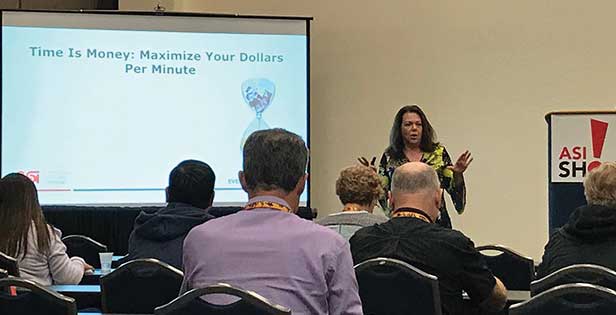February 04, 2019
Protecting Your Valuable Selling Time
What two attributes make something valuable? It comes down to a simple formula, according to Carolyn Strauss of Carolyn Strauss Consulting: it must be both useful and scarce. For sales professionals, their time is their most valuable resource and must be protected and used wisely. But it’s a perpetual challenge, said Strauss during her session “Time is Money: Maximize Your Dollars Per Minute” at ASI Fort Worth.
Too often, she told the audience, people let others take their time away from them, in both personal and professional relationships. “The people in our lives look good, and fit us well at first,” Strauss said. “But then as time goes on, they don’t fit so well anymore. We have to move towards the positive people and away from the negative.”

Education Day speaker Carolyn Strauss
Strauss added that people, particularly sales reps, make the mistake of being too available because they think that’s what makes them valuable. For example, if a client calls during a busy time, reps may just let them talk, thinking that being there for them makes them more valuable in the client’s eyes. Strauss reminded attendees that when something isn’t scarce, it’s not valuable. So having the confidence to put parameters on time protects it and allows reps to work smarter.
Strauss recommended creating a client “relationship map” to see where an individual sales rep’s time is spent; she suggested taking a list of clients and ranking them by how often a rep interacts with them, from “always to almost never.” By circling the names of “positive” people and putting an X next to those who are “negative,” who take more than they give, reps can gauge exactly where their time is spent. Strauss said often, the negative people tend to be closer to the “always” category than the positive ones.
“Negative clients should get five minutes or fewer of your time,” she said. “Or fire them. You’re an offer of help. You’re not just there to sell. They give the products you provide to them to end-users in order to make them more valuable, more positive to those recipients.”
If a client needs to be fired, it can be an uncomfortable situation, but Strauss said to be firm since a precious commodity – time – is on the line. “Give them a call and say to them, ‘It seems like our help isn’t what you need right now,’ and tell them you won’t be contacting them anymore,” she said. “They either go away, or they come back and do business with you. We’re afraid of losing something more than we are of gaining something.”
Reps also lose precious selling time by trying to figure out what their clients need over email, what Strauss called “gambling with time.” She said one of the biggest time-wasters in a sales rep’s day are emails from clients saying they’d like to reorder the products they bought some time ago, with no further details. With hundreds of clients, trying to figure out exactly what the client wants could take a substantial amount of time.
Strauss recommended using the SBAR (Situation, Background, Assessment and Recommendation) system, which is put into regular use by the military and healthcare professionals. You might, for example, ask clients to tell you exactly what they had ordered before (Situation); what they currently need it for (Background); what they want changed for this order, like font, color or imprint (Assessment); and the next steps they’d like the rep to take, whether it’s a request for a call, email or catalog (Recommendation).
“It’s easy to train your clients in SBAR,” she said. “Say to them, ‘Try our new email format to let us know what you need.’ This way you don’t have to do any other work besides your actual work. You’re not spending 30 minutes figuring out what they’re talking about. Your time is valuable. You have to think about dollars per minute.”